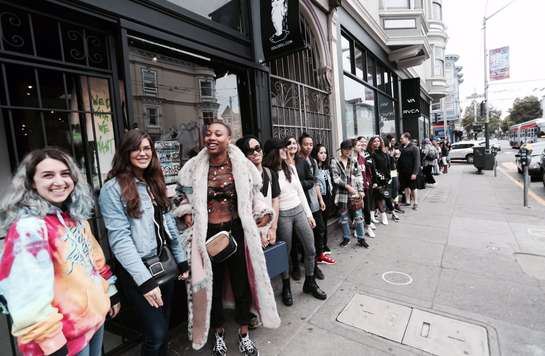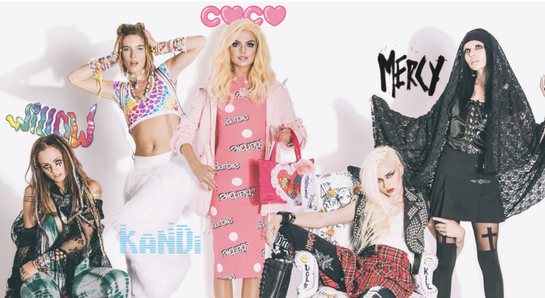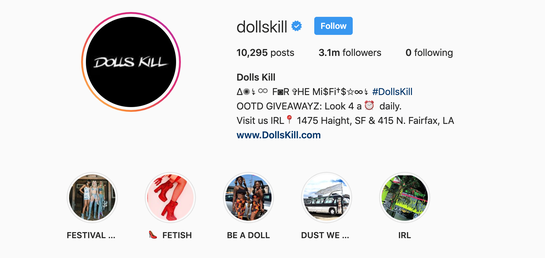How to Build Brand Recall in a Clickless World
Brand awareness is dwindling in organic search. Here's your strategy for building brand equity and recall by leveraging brand awareness. Learn more here.
Read More
The Dolls Kill brand has been compared to Nasty Gal and Hot Topic. These comparisons seem valid on the surface. Like Hot Topic, Dolls Kill is plugged into the rock and roll ethos that elevates the middle finger (pun intended) into a statement of identity, and like Nasty Gal, Dolls Kill thrives and wallows in the risque and the untoward. But both of these comparisons miss something: Dolls Kill is really the anti-Supreme.
That might seem counterintuitive — both Dolls Kill and Supreme were born out of the same counter-cultural ideals of rebellion, attitude, and bravado. Both brands cater heavily to a niche audience that stands apart from traditional market demographics and are built firmly on the visions of their creators. Both say something about the times and are a slightly twisted reflection of the world that produced them. That’s where the similarities end, though. Despite some superficial overlap, the two brands have completely different approaches and a wildly different ethos.
Unlike the founder of the red-logoed skate and street-wear brand Supreme, who was never a skater himself, Dolls Kill was born from the culture they represent. Founder Shaudi “Shoddy” Lynn met her co-founder and husband Bobby Farahi while she was DJing a rave and he was celebrating the successful sale of his media tracking company. They bonded over their love of electronic music, eclectic fashion, and entrepreneurship.
Image: Inc.com
Shortly after meeting, the two began collaborating on a line of accessories for the ravers and club-goers they partied with. The Dolls Kill brand started as an eBay shop reselling a fox-tail keychain they bought from China, and slowly expanded to other accouterments that complete an outfit for someone heading to a warehouse for a weekend of hard bass and harder dancing.
Founded with the money Farahi had from the sale of his previous company, Dolls Kill quickly transitioned from eBay to e-commerce, and from accessories to a full fashion line. The company was profitable from day one, and in 2015 managed to earn the #33 spot overall on the Inc 500, and the #1 spot among retailers. Since then, they’ve taken three rounds of investment. The first two rounds were led by Maveron and the latest, a $40 million round, was led by Silicon Valley big-shots Sequoia. Altogether, the company has raised over $60 million, bringing the company’s valuation to a rumored value of over $400 million.
More incredibly, the brand managed to get there with virtually no advertising — a few sponsored social media posts and the occasional experimentation with pay-per-click (PPC), but nothing on the scale that most fast-growing fashion houses spend. That may sound similar to Supreme, but it also points out another key point of differentiation. Supreme may have a robust digital presence, but they were always a brand rooted in a physical place — their flagship NYC store and the neighborhood it grew out of. It was a brand defined by geography and “real world” retail.
Dolls Kill never had that. Though they’ve opened stores in San Francisco and LA, the Dolls Kill brand is a digital native. They exist everywhere and nowhere, and grew up on the web. The physical locations are just another storefront, not the defining soul of the company. This has given them a wide range of flexibility in what they sell, how they sell it, and who they sell it to. As a result, the brand was able to build a large following across the world — they estimate about half of their customers are outside of the U.S. — and were given the opportunity to play with business models, like a parody of the pop-up and drop approaches in which they drove an ice cream truck through multiple cities selling limited edition boots.
Customers outside of the Dolls Kill location in San Francisco / Image: Twitter
It can be easy to write Dolls Kill off as just another 20-something extreme fashion brand making a name for itself on Instagram. E-commerce companies like Black Milk Clothing, which made a name for itself during the early years of the “nerd” revival and then faded from the spotlight, or Nasty Gal, which went into sudden bankruptcy protection in 2016, have been a perennial staple of the startup world since the days of Pets.com. They’re born, they shine bright, and then they fade into obscurity or insolvency when the next hot thing comes along.
But there are a lot of reasons to suspect that Dolls Kill has found something different. Not least of which is the support of two top-tier VC firms (first Maveron and now Sequoia), and their top-notch board of directors, which includes the former CEO of Hot Topic. The brand has strengths that many of their former competitors didn’t have, much like Supreme, plus a few tricks of their own.
Call it a buzzword, or an obsession, or a trend, but millennial and Gen Z consumers are constantly searching for something real. Whether it be an authentic voice, an authentic experience, or an authentic avocado toast, it seems to be the defining feature of the largest cohort of young shoppers since the baby boom.
The Dolls Kill brand has it in spades. The brand was born from active participants in the cultures they represent. They aren’t following trends by looking at market reports, they’re living them. Shaudi Lynn was still DJing through most of the brand’s growth and only stopped when the day-to-day of running the company got to be too much. Unlike many of their competitors, everyone at the company is deeply immersed in the worlds that they build and the fashion they put on their site.
This even extends to the models. Rather than hiring professional models, or “dolls” as the company calls them, Dolls Kill solicited photos from their fans and followers. This turned into a “Be a Model” contest, which ended with the company hiring the winners, who are still with them today. This kind of fan engagement, combined with “DJ Shoddy”’s endorsements from the DJ booth, gave customers the sense that the brand wasn’t some abstract construct, but a part of their community.
While Supreme has built a billion-dollar company on the principles that shopping there should be as difficult as possible, Dolls Kill took the opposite approach. The company still has some limited edition items, and occasionally does drops of limited-run goods, but mostly they sell everything all the time, to anyone that wants to buy it. And at affordable prices, to boot.
Rather than follow the tradition of gate-keeping that often comes along with these intimate communities, the company has gone out of its way to be inclusive of a wide range of cultures and styles. They currently have six dolls (which is also how the company refers to its separate lines). There’s the cutesy “kawaii” girl (Coco), the free-spirited festival girl (Willow), the drinks, drugs, and dance raver girl (Kandi), the dark and brooding goth girl (Merci), the in-your-face punk girl (Darby), and the sassy streetwear girl (Mia). These cultures span a huge swath of pop culture, but the company allows and encourages them to coexist peacefully.
Image: Twitter
More than that, Dolls Kill makes these subcultures just as accessible, whether you live and breathe one of these lifestyles or if you’re just dipping a toe in or picking up a single piece for a special occasion. There’s no bar of involvement to clear, no shibboleth to memorize, no secrets to decode to find the latest special edition drop, and everything is priced to be affordable even on a budget. In many ways, Dolls Kill has taken the fast fashion model and recreated it for a bit more of a specialized audience.
We’ve touched on community in a couple of points so far, but it’s impossible to stress enough how much community has played a role in the brand’s growth and how the previous two growth drivers have allowed it to be built. Authenticity has allowed the founders to bond with their fans in a way that most fashion brands can only dream of. After all, when was the last time Virgil Abloh DJed a club that his customers were dancing at? Or is there another example when a brand’s in-house models were real customers who interacted with their fans in a genuine way in person and over social media? That’s supported by accessibility — the brand has built a strong culture out of making everyone who works there be in a position where they can freely and openly interact with the people they sell to.
The social community the brand has built has been a fundamental part of their growth. Since being founded, the company has managed to grow Instagram followers to over 3 million — almost half of the much larger, more iconic, older, and far more deep-pocketed Saint Laurent. And with more and more commerce moving directly to social media since the introduction of Instagram Shopping and in-app purchases and checkout, an engaged social audience is critical to success. The future of online retail, and possibly all retail, is an activated community that allows brands to combine their marketing, customer service, and sales into one seamless unit.
Image: Instagram
Though it’s not talked about as often, one of the keys to Dolls Kill’s success is that they aren’t primarily a direct-to-consumer (D2C) brand. They’re also not just a marketplace. Instead, they walk somewhere down the middle, with in-house brands sharing virtual shelf space with partner brands. Rather than try to go one way or the other, the founders chose to focus on curation and cohesive collections that fit their creative vision.
This is an important point as D2C continues to gain steam — your business model should always be secondary to your customer experience. Going all-in on direct-to-consumer works if you can find efficiencies and specific benefits to handling the entire supply chain from start to finish. Likewise, being a marketplace is good if you have a clear vision of what you want to sell. But trying to shoehorn a brand experience into a specific model just to be in-step with current trends is rarely the best approach to take.
The approach taken by Dolls Kill — selling external brands when they fit their vision, or creating their own when they see an opportunity — allows them to tap into the best of both worlds. More importantly, it allows them to present a singular, unified concept to their audience. Everything they sell is true to who they are, whether it’s made by Dolls Kill or not.
Brands, especially in youth and fast fashion, tend to come and go. They rise up out of nowhere, fueled by hype and driven by the latest “it” trend, and then tend to flame out quickly, never to be heard from again. Smart brands, however, are able to turn these break-out moments into long-lasting success. Supreme did so by making sure they were always early adopters of whatever the next big “it” trend happened to be (given the current direction of menswear, get ready for a modest and shockingly low-key two-piece suit from them in 2020). Dolls Kill, on the other hand, has managed to grow and thrive over their eight-year run by picking the “it” trends it wants to be part of and sticking to them with ferocity and passion. The lessons they teach us are:
Last updated on April 23rd, 2025.



